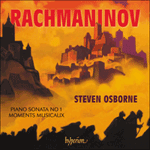
Welcome to Hyperion Records, a British classical label devoted to presenting high-quality recordings of music of all styles and from all periods from the twelfth century to the twenty-first.
Hyperion offers both CDs, and downloads in a number of formats. The site is also available in several languages.
Please use the dropdown buttons to set your preferred options, or use the checkbox to accept the defaults.
It is easy to imagine that the forbidding darkness of the Prelude in D minor (published posthumously in 1973) was the composer’s reaction to these events. Rachmaninov was probably alluding to the grinding dissonances of Chopin’s A minor prelude, which he knew intimately. The chilling chords move slowly and distractedly at first, but as they gather momentum a sinister dance begins to emerge, only to dissipate before it can take off, and the bleak ruminations return.
from notes by Marina Frolova-Walker © 2022
On imagine aisément que l’obscurité menaçante du Prélude en ré mineur (publié à titre posthume en 1973) fut une réaction du compositeur à ces événements. Rachmaninov fait sans doute allusion aux dissonances grinçantes du prélude en la mineur de Chopin, qu’il connaissait intimement. Les accords effrayants avancent tout d’abord lentement et distraitement, mais, lorsqu’ils prennent de l’élan, une danse sinistre commence à émerger; elle se dissipe néanmoins avant de pouvoir prendre son essor, et les mornes ruminations reviennent.
extrait des notes rédigées par Marina Frolova-Walker © 2022
Français: Marie-Stella Pâris
Man kann sich durchaus vorstellen, dass die abweisende Dunkelheit des Prélude d-Moll (1973 posthum veröffentlicht) die Reaktion des Komponisten auf diese Ereignisse war. Wahrscheinlich spielt Rachmaninow auf die sich reibenden Dissonanzen aus Chopins Prélude a-Moll an, welches er sehr gut kannte. Die beängstigenden Akkorde bewegen sich zunächst langsam und zerstreut, sobald sie jedoch in Gang kommen, beginnt ein unheimlicher Tanz, der sich allerdings auflöst, bevor er abheben kann, woraufhin die düsteren Grübeleien zurückkehren.
aus dem Begleittext von Marina Frolova-Walker © 2022
Deutsch: Viola Scheffel
 Rachmaninov: Piano Sonata No 1 & Moments musicaux Rachmaninov: Piano Sonata No 1 & Moments musicaux‘Rachmaninov fans won’t want to miss this’ was Gramophone’s verdict on Steven Osborne’s Études-tableaux, and this thrilling release is an equally essential acquisition. Osborne proves a predictably fine exponent of the Faustian Piano Sonata No 1, ...» More |
 Rachmaninov: Preludes & Melodies Rachmaninov: Preludes & MelodiesIn his second solo piano recital album for Signum, Alessio Bax further demonstrates his dazzling skill and flair in performance and interpretation—this time with Rachmaninov’s piano works. Centered around the Preludes op 23, the programme is descr ...» More |
 Rachmaninov: The Complete Solo Piano Music Rachmaninov: The Complete Solo Piano Music‘A fine achievement from Howard Shelley and Hyperion alike. These superbly recorded, idiomatic readings demonstrate Shelley's virtuoso pianism and aff ... ‘A significant testimony to Howard Shelley's artistry. Pianistically impeccable, he understands what Rachmaninov was about’ (Gramophone)» More |

